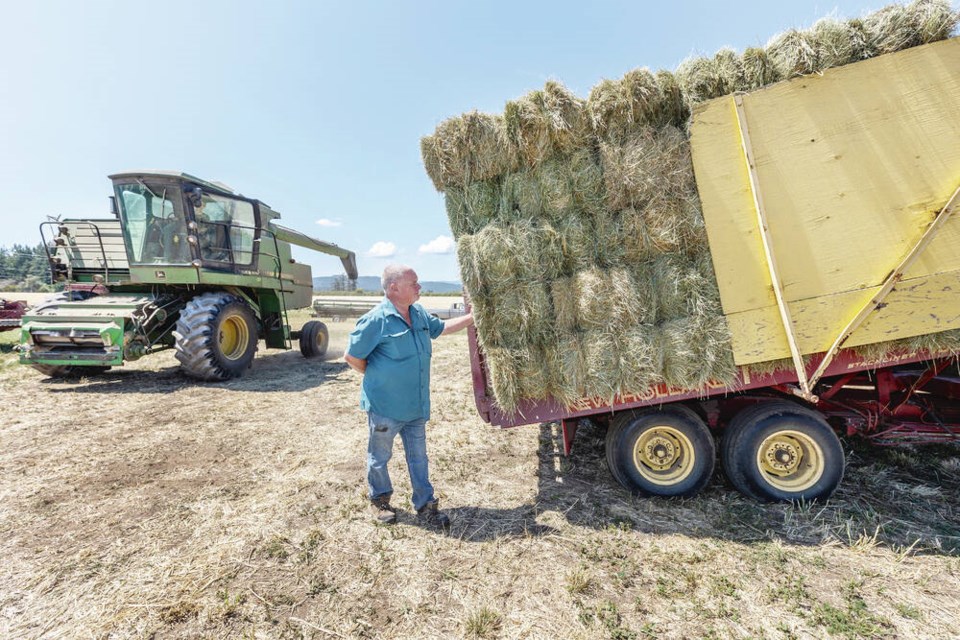Bryce Rashleigh called it the “miracle rain.”
On June 9 and 10, the skies opened over the Saanich Peninsula and poured down almost 30 millimetres of rain.
The downpour helped save Rashleigh’s hay crop at Saanichton Farm from almost certain disaster amid a prolonged drought, and will go a long way to boosting his barley crops — destined for the vats of local scotch whiskey and beer producers.
“I just stood out in the yard and got myself soaked … I’ll tell ya, I’ve never felt so good,” said the Saanichton farmer. “It absolutely saved us.”
Rashleigh — one of the largest hay growers on the south Island — was able to produce enough hay to help at least some of the beef producers and horse owners in the capital region, as well as a few dairy farmers and ranchers over the Malahat, get through spring.
And the rainfall gave a needed jolt to his wilting barley crops, which will be sold to Phillips Brewing and Macaloney’s Island Whiskey. Harvesting of the grain is expected to start early next week.
Rashleigh has delivered about 300 large round bales of hay — as much as her farm can store — to Donna Friedlander, who operates Tally-Ho Carriage Tours and has 23 horses on her Central Saanich farm.
“I can’t thank him enough,” said Friedlander, who knows of others who are running low, as a drought that started last fall and continued in the spring and into the summer has severely limited hay growth and stunted pastures.
Rashleigh was able to grow about 5,000 big round bales of hay this year, down from the yearly average of 8,000 over the past few decades.
That means he will only be able to serve his regular customers and won’t have any surplus to sell to others who are running short.
“We didn’t get enough rain in the spring and then when we fertilized, the rains didn’t come to utilize it,” said Rashleigh.
His 700 acres of barley seeded over a patchwork of fields from Deep Cove to the Blenkinsop Valley is also expected to produce below-average yields. “The seed size will be smaller and the weight down, but it will be a better crop than two years ago when we had the heat dome,” said Rashleigh.
Both hay and grain are valuable commodities as drought conditions drive up demand and prices across the country.
Livestock producers in B.C. and on the Prairies are experiencing severe drought that has affected pastures, hay production and crops, leaving some considering selling off their herds.
British Columbia’s River Forecast Centre says several of the province’s 34 water basins are at extreme levels of concern, including all of Vancouver Island, meaning water wells, irrigation sources such as rivers and lakes and private ponds are getting dangerously low.
Lorraine Buchanan, who runs Parry Bay Sheep Farm in Metchosin with her husband, John, said downsizing their herd of 280 ewes is a possibility.
Their hay field production is down between 30% and 40% from last year and their pastures are depleted of grass.
“We’re feeding the ewes [hay] now, which we never do in July,” Lorraine Buchanan said Friday. “That’s using up our hay, and hay prices are very high.”
She said hay prices have shot up to between $20 and $30 for a small 55-pound bale. They’ve been feeding their herds bales of hay costing them as much as $400 a day, something they don’t normally do until the ewes are off pastures in September or October.
In normal years, the Buchanans are able to sell a lot of hay to augment their farm income. They’re typically able to irrigate some hay crops from a pond at the farm, but this year with practically no rainfall, they’ve had to tap into municipal water, which is expensive.
Rashleigh said big round bales range from $85 to $130 — a year ago, they were $65.
He said rising operating costs are stinging producers. Fertilizer has nearly doubled to $1,400 a tonne compared to two years ago, he said, and fuel costs continue to skyrocket.
A part for his swather — a machine that cuts hay and grains and forms it into windrows for drying — that cost $20 a few years ago now costs $375, said Rashleigh. “All these rising costs really add up, so you can see why food in general is getting more expensive.”
Rashleigh said he’s only increased his prices based on his input costs, and he’s only selling hay to the customers he’s had for years. “I could get more [for it],” he said. “But you have to support the farmers around you. If they don’t survive, none of us do.”
This week, Agriculture Minister Pam Alexis said the province is looking at other jurisdictions where there may be a surplus of hay, primarily eastern Washington.
The province is working with the B.C. Cattlemen’s Association to compile a list of hay growers to connect them with B.C. buyers.
The federal government gave the province the green light to provide advance payments to farmers with cash-flow issues under the AgriStability program.
“What we’re doing is somewhat of a dating service from producers to suppliers,” said Kevin Boon with the B.C. Cattlemen’s Association.
“This is an issue where we have to care for our animals, and so decisions have to be made at some point in time. If they can’t access feed, they are going to have to make a hard decision of what to do with those animals.”
Boon said that the long-term drought also raises questions about long-term storage and allocation of water.
>>> To comment on this article, write a letter to the editor: [email protected]



